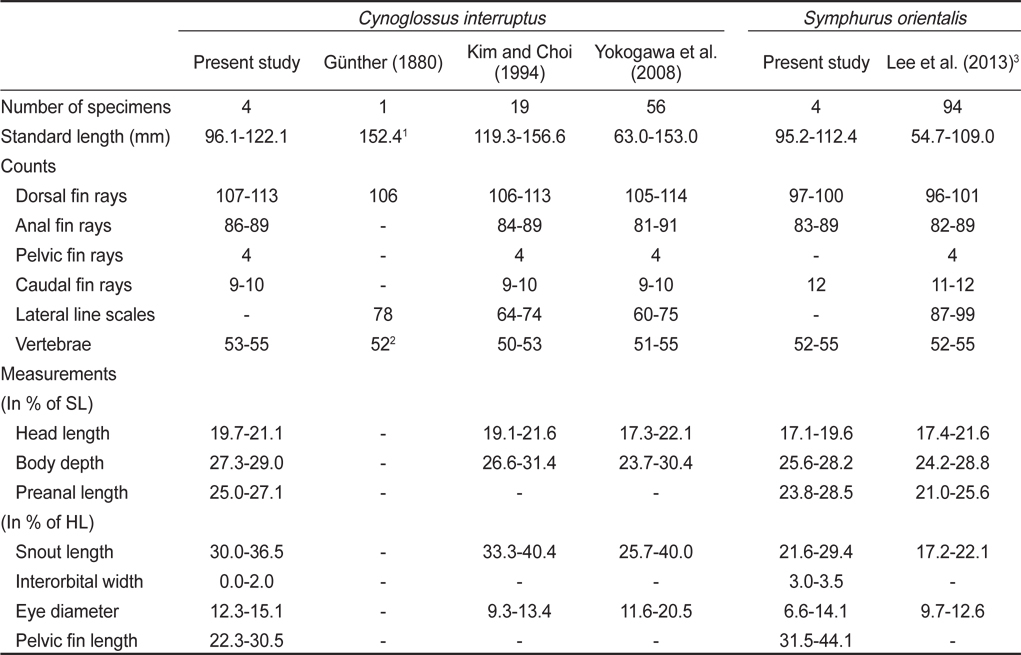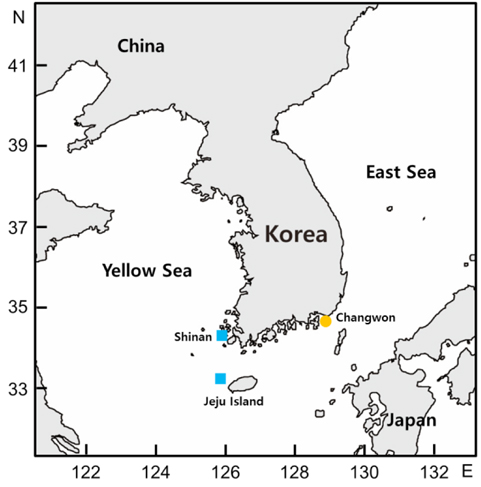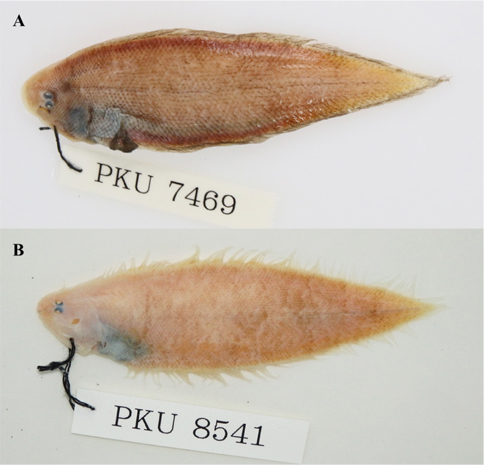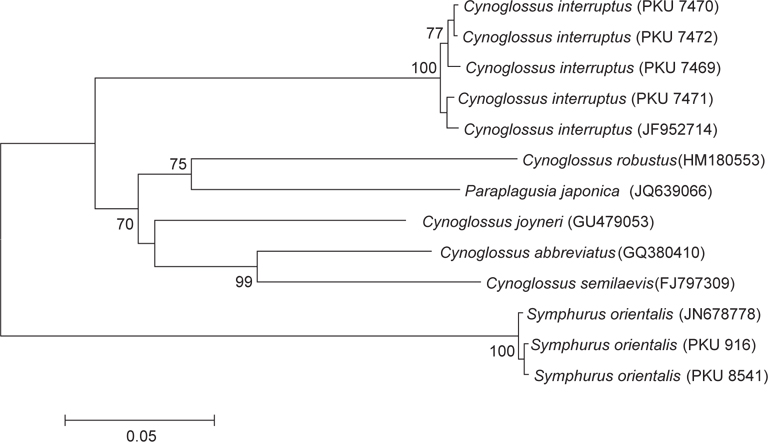



가자미목(Pleuronectiformes) 참서대과(Cynoglossidae) 어류는 열대 및 아열대 해역에 서식하는 저서성 어류로 전 세계적으로 3속 127종(Menon, 1977; Munroe, 1998; Nelson, 2006), 국내에는 3속 8종이 보고되어 있다(Kim and Choi, 1994; Kim et al., 2005). 참서대과 어류는 몸이 매우 측편되어 있으며, 눈은 몸의 왼쪽으로 돌아가 있고 등지느러미 및 뒷지느러미가 꼬리지느러미와 연결되어 있는 것이 특징이다(Menon, 1977; Nelson, 2006). 본 과는 2아과로 구분되는데, 주둥이가 갈고리형으로 휘어진 입이 주둥이 아래에 있고 유안측에 측선이 존재하면 참서대아과(Cynoglossinae), 주둥이가 갈고리형이 아니고 직선형 입이 주둥이 앞에 있으며 유안측에 측선이 없으면 보섭서대아과(Symphurinae)로 구분된다(Chyung, 1977; Menon, 1977; Nelson, 2006). 국내에서는 용서대
따라서 본 연구는 국내에서 처음으로 형태 및 분자분석을 통해 보섭서대와 칠서대를 재동정하여 한국해역에 분포하는 것을 확인하였고 상세히 재기재하였다.
칠서대 4개체는 2012년 10월 경상남도 창원 연안에서 채집되었으며, 보섭서대 4개체는 2007년 4월과 2013년 3월 제주 및 전라남도 신안 연안에서 채집되었다(Fig. 1). 계수 및 계측은 Hubbs and Lagler (2004)과 Munroe (1992)를 따라 버니어 캘리퍼스를 이용하여 0.1 mm 단위까지 측정하였다. 지느러미줄기수 및 척추골수는 Soft X-ray (Hitex HA-100, Japan; SOFTEX M150, Japan)를 이용하여 계수하였다. 등쪽 담기골 끝부분이 신경극 사이에 삽입된 형태(Interdigitation pattern of dorsalfin pterygiophores and neural spines: ID)는 Munroe (1992)를 따라 확인하였다. 본 연구에 사용된 표본은 부경대학교(Pukyong National University, Korea: PKU)에 등록 및 보관하였다. 분자분석을 위한 DNA추출과 중합효소연쇄반응은 Kwun and Kim (2013)을 따라 수행하였으며, 미토콘드리아 DNA Cytochrome Oxidase Subunit I (COI) 영역을 증폭하기 위해 VF2 (5`-TCAACCAACCACAAAGACATTGGCAC-3`)와 FR1d (5`-CACCTCAGGGTGTCCGAARAAYCARAA-3`) Primer를 이용하였다(Ward et al., 2005; Ivanova et al., 2007). 염기서열은 DDBJ/EMBL/GenBank database에 등록하였다(accession numbers: KU234514–KU234519). 염기서열 정리는 BioEdit version 7 (Hall, 1999)의 ClustalW (Thompson et al., 1994)를 이용하였으며, 비교어종으로는 참서대과에 속한
>
Cynoglossus interruptus
표본: PKU 7469-7472, 4개체, 체장 96.1-122.1 mm, 경상남도 창원, 2012년 10월 12일.
기재: 몸은 타원형으로 약간 길고 심하게 측편되어 있다. 주둥이는 갈고리 모양으로 앞쪽 부분은 약간 뾰족하다. 유안측 콧구멍은 1쌍으로 전비공은 관형, 후비공은 구형이다. 입은 작고 주둥이 아래에 있으며, 촉모(fringes)가 없다. 무안측에는 가늘고 작은 원뿔니가 2-3열 있으며, 유안측에는 이빨이 없다. 눈은 작고 양안간격은 매우 좁다. 등지느러미 기점은 주둥이 앞쪽부분에서 시작한다. 뒷지느러미 기점은 배지느러미 뒤에서 시작하며, 배지느러미와 막으로 연결되어 있다. 꼬리지느러미는 약간 뾰족하며, 등지느러미 및 뒷지느러미 뒷부분과 부드럽게 연결되어 있다. 가슴지느러미는 없다. 유안측에는 2개의 측선이 있으며 중앙 측선은 꼬리지느러미 앞까지 발달되어 있고, 등쪽 측선은 불완전하게 발달되어 있다. 머리에는 다방향으로 분지된 측선이 발달되어 있다. 안상선(supraorbital line)과 중앙 측선 사이에는 1열의 비늘열이 있다. 유안측과 무안측 모두 머리와 몸은 작은 빗비늘로 덮여있다.
체색: 유안측 머리와 몸은 갈색이며, 무안측은 전체적으로 흰색에 등쪽과 배쪽은 황색을 띠고 반점이 없다. 등지느러미와 뒷지느러미는 반투명한 갈색이며 깨알같은 점이 있다.
분포: 우리나라 부산, 여수, 창원(Kim and Choi, 1994; Kim et al., 2005; 본 연구), 대만(Shen, 2001), 일본(Yamada and Yagishita, 2013), 중국(Menon, 1977).
분자분석: 참서대과 어류 2종 6개체로부터 얻은 미토콘드리아 DNA COI 영역 603 bp (base pair)를 이용하여 분석한 결과, 칠서대 4개체는 일본산
부기: 한국연안에서 채집된 칠서대 4개체는
[Table 1.] Meristic and morphometric characters of two cynoglossid fishes

Meristic and morphometric characters of two cynoglossid fishes
>
Symphurus orientalis (
표본: PKU 916-918, 3개체, 체장 95.2-112.4 mm: 제주도 제주, 2007년 4월 24일; PKU 8541, 1개체, 체장 99.6 mm, 전라남도 신안, 2013년 3월 15일.
기재: 몸은 타원형으로 약간 길고 심하게 측편되어 있다. 주둥이는 갈고리 모양이 아니며 앞쪽 부분은 약간 뾰족하다. 유안측 콧구멍은 1쌍으로 전비공은 관형, 후비공은 구형이다. 입은 작고 주둥이 앞쪽에 있으며, 촉모(fringes)가 없다. 무안측에는 작은 원뿔니가 3-4열로 있으며, 유안측에도 가늘고 작은 원뿔니가 1열로 있다. 눈은 작고 양안간격은 매우 좁다. 등지느러미 기점은 눈 위에서 시작한다. 뒷지느러미 기점은 배지느러미 뒤에서 시작하며, 배지느러미와 분리되어 있다. 꼬리지느러미는 약간 뾰족하며, 등지느러미 및 뒷지느러미 뒷부분과 부드럽게 연결되어 있다. 유안측 몸에는 측선이 없다. 유안측과 무안측 모두 빗비늘로 덮여있다. 등쪽 담기골의 삽입형태는 1-2-2-2-2 이다.
체색: 유안측 머리와 몸은 밝은 갈색에 다수의 불명확한 어두운 갈색 무늬가 있으며, 무안측은 전체적으로 흰색에 반점이 없다. 등지느러미와 뒷지느러미는 반투명한 옅은 갈색이며 반점이 없다.
분포: 우리나라 제주도, 신안(Kim et al., 2005, 본 연구), 대만(Shen, 2001; Lee et al., 2013), 일본(Yamada and Yagishita, 2013).
분자분석: 참서대과 어류 2종 6개체로부터 얻은 미토콘드리아 DNA COI 영역 603 bp (base pair)를 이용하여 분석한 결과, 보섭서대 2개체는 대만산
부기: 한국연안에서 채집된 보섭서대 4개체는



